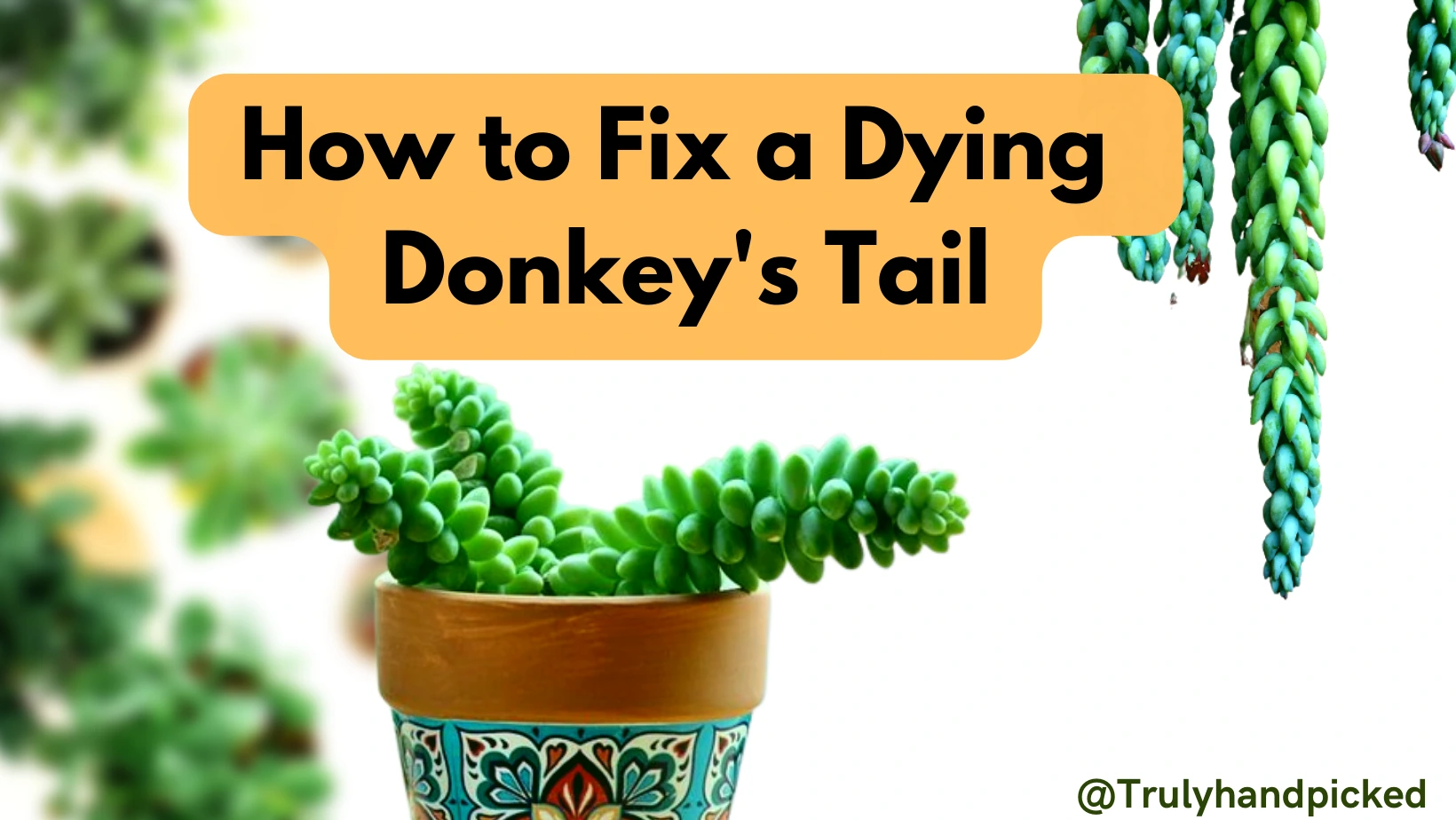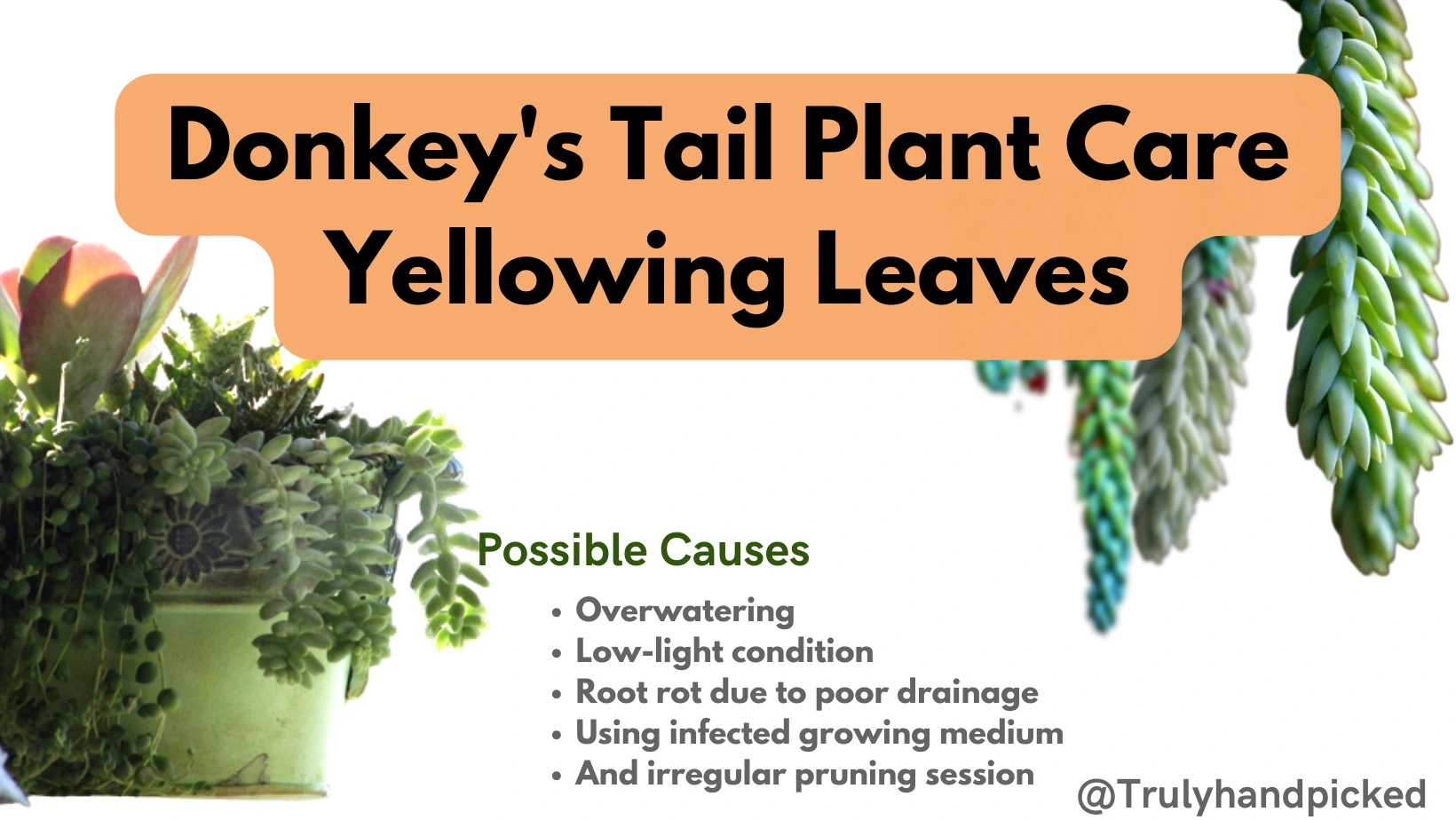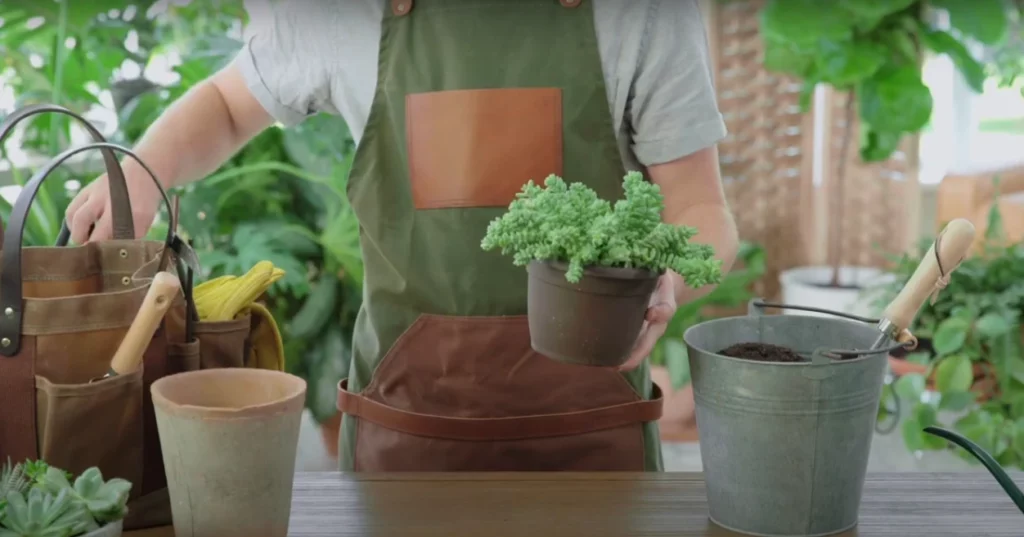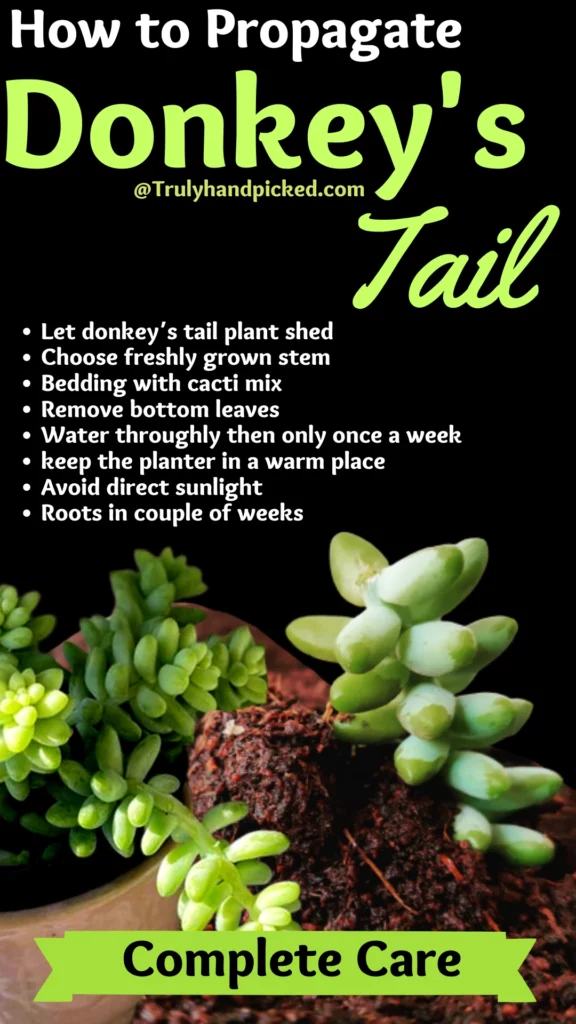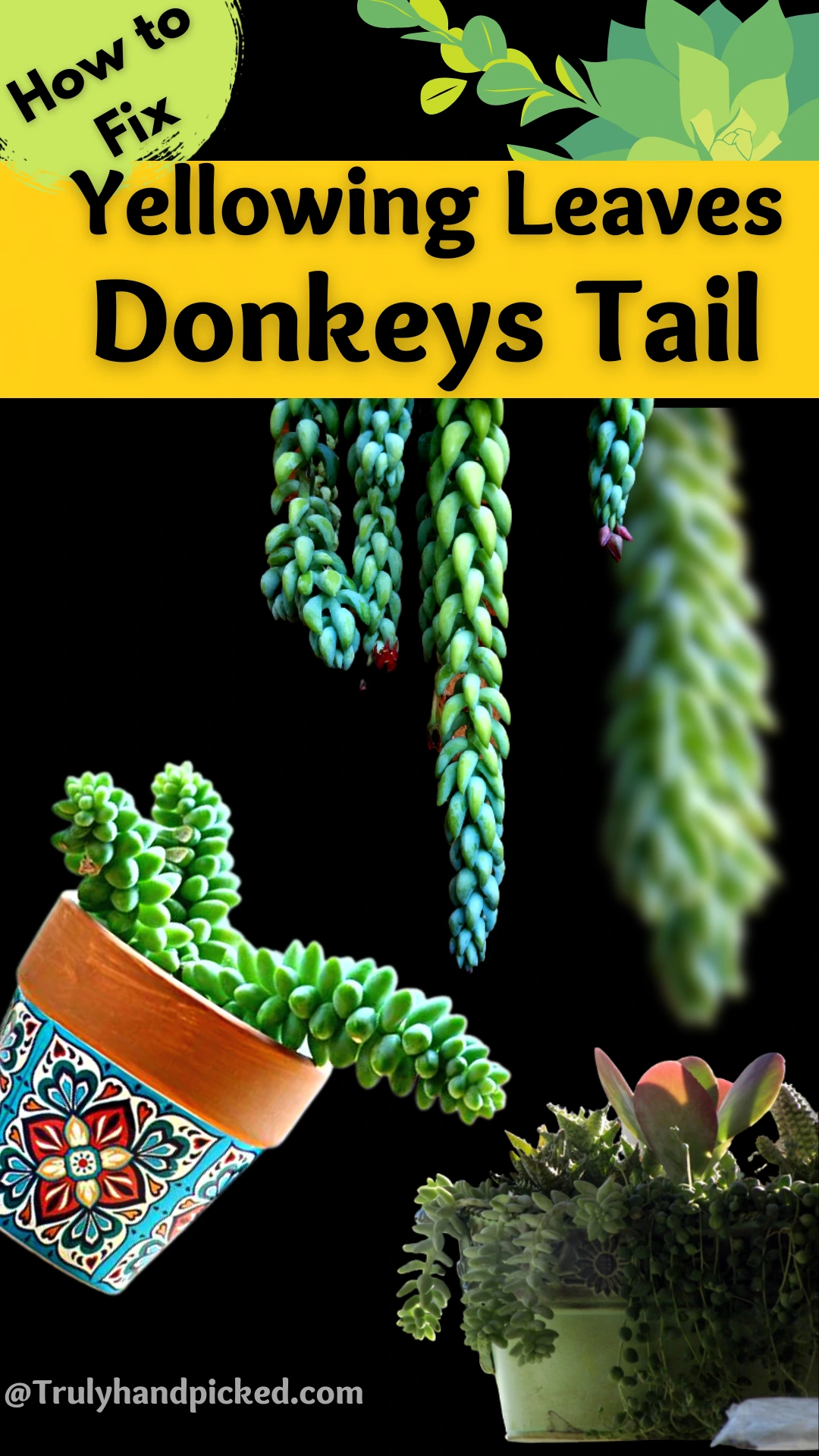Reasons why your donkey’s tail plant leaves are turning yellow, how to fix and prevent dropping leaves of your succulent. Burro’s tail succulent care and quick tips.
Contents: Reasons for Yellow Leaves | How to Fix Yellow Leaves | Save a Dying Succulent | Donkey Tail Complete Plant Care | How to Propagate| Recap on yellow leaves
Donkey’s Tail Succulent: Plant Care
A donkey’s tail (Sedum morganianum) is a beautiful ornamental succulent. It grows best vertically in a hanging basket or dangling planter. This perennial succulent belongs to the Crassulaceae family and is native to the southern part of Mexico country.
It produces trailing stems in a bluish-green shade and blooms with pink to red blossoms sometimes. Its sprawling texture grows up to 23-24 inches long and thus could make a brilliant houseplant.
Despite its fragile look, a donkey’s tail aka burro’s tail plant is very effortless to handle. Here are some imperative facts about a growing donkey’s tail plant, you should know to cultivate it more confidently-
Why Is My Donkey’s Tail Leaves Turing Yellow?
In short: Too much sun exposure and over-watering are the most common reasons for a burro’s tail turning yellow. Partial or indirect bright sun and well-draining soil and occasional watering is the key. Let’s check in detail.
You may find that your burro’s tail or donkey’s tail plant leaves sometimes turn yellow. This may happen due to improper caring methods. This succulent is not a very high-maintenance species, yet it is quite particular about its fundamental needs. Low maintenance doesn’t mean zero maintenance 😉
If you ever be inattentive towards your plant for long, you may find that the bluish-green trailing foliage begins to turn yellowish shortly.
Reasons:
- Overwatering
- Scorching direct sunlight
- Low lighting condition
- Root rot due to poor drainage
- Using an infected growing medium
- An irregular pruning session
Related: How to save an overwatered succulent
How to Deal with Yellowing Leaves:
- Too much scorching sun can also damage the leaves and make them look yellow
- Stop over-watering and move your succulent to a location with 4-5 hours of bright indirect light
- Less is more for a donkey’s tail when it’s come to the matter of watering
- If it doesn’t recover, check for root rot as it can’t get back on its own
- Take the succulent out of the planter without damaging the roots
- Clean and find the mushy roots and prune them off
- Let the plant alone in a shady ventilated space for a day to two
- Now place your succulent in a well-draining planter with a fresh succulent potting mix
- Always use fresh soil and disinfected tools
- Your plant has enough water in its leaves so, don’t water it often
- Watering twice a month and bright indirect sunlight will keep it healthy
- Keep your succulent well-pruned. Purring will keep the healthy part of your plant safe from getting infected by old leaves
- And be attentive to your plant consistently(fix issues asap), throughout its entire growing session.
How to Save a Dying Donkey Tail?
Untreated troubleshooting issues sometimes lead your growing donkey’s tail plant toward a fatal outcome. Fortunately, you can prevent this inevitable conclusion and revive your donkey’s tail succulent by successfully applying some smart tricks. Here are the most useful tips in this regard-
- Use a proper planter that can hold the weight of such bushy succulents easily. This will help to keep the root of your plant strong enough to hold
- Do not water a growing donkey’s tail more than once every 8-12 days (depends upon climate too)
- Let the soil dry and do not make the soil of your plant soggy ever
- Keep your plant where it can grab bright sunlight through full sun exposure
- Do not let the temperature of your room less than 50° F, where it stays
- Do not overfertilize you’re succulent more than once or twice a year
- Skip fertilization during the winter season
- Makes sure your plant is draining the excess water properly
- Prune and repot your plant in time, when it is necessary (and careful with succulent leaves while repotting)
- Apply any possible remedy to get rid of any pest or bug around your plant
- And save your plant from frosty drafts during freezing winters (prevents cold stress).
How to Care Donkey Tail Succulent?
Quick Shots:
Soil:
- Well-draining soil mix.
- Use cactus or succulent soil.
- Add perlite or pumice for better drainage.
Light:
- Bright, indirect sunlight.
- Protect from intense, direct sun.
- 4-6 hours of sunlight daily.
Water:
- Allow soil to dry between waterings.
- Water thoroughly, then let excess drain.
- Avoid overwatering to prevent root rot.
Fertilizer:
- Use balanced, diluted succulent fertilizer.
- Apply during the growing season.
- Avoid fertilizing during dormancy.
Propagation:
- Propagate from stem cuttings.
- Let cuttings callus before planting.
- Plant in a well-draining soil mix.
Additional Care:
- Maintain average room temperature.
- Protect from frost and extreme cold.
- Handle with care, as leaves are delicate.
Soil and Water:
This succulent prefers loamy or sandy-type soil with well-drained quality. Keep the pH level between neutral to slightly acidic for the best result.
This succulent is drought-tolerant, thus watering it with more gaps. Try to maintain the watering schedule once every two or three weeks. Let the soil dry between watering and use distilled water for a better outcome.
Related: Best trailing succulents for your hanging baskets
Sunlight and Climate:
A donkey’s tail thrives best when placed constantly under full sun exposure and a bright light source. Try to hang your planter near an east-facing window to provide the best kind of sunlight.
It always prefers a tropical warm climate with a proper temperature between 65° to 75° F. This plant isn’t much picky about the humidity level. Just make sure, you don’t place the plant in an extremely low-humidity level for long.
Related: Best low-light succulents for indoors
Proper Fertilization:
A donkey’s tail is a low-feeder and sometimes, you don’t need to feed your plant at all to grasp its proper growth. You can fertilize your plant once a year to fulfill its nutrient requirements.
Use any controlled-released balanced fertilizer with one-quarter strength in a 20-20-20 NPK ratio. If you are feeding your plant at the primary stage, maintain the ratio in a 10-20-20 way.
Related: How not to kill your succulents – plant care
Video on Donkey’s Tail Plant Care
Pruning and Repotting:
Prune your growing donkey’s tail plant once a year and try the process during springtime. Trim down old leaves, any infected or discolored leaves, leggy stems, and leaf not during this process. This will encourage the growth of your plant and keep it in a beautiful shape as well.
Donkey’s tail succulent is highly delicate, and you should not touch this plant much to keep its growth consistent. So, try not to repot or replant a growing donkey’s tail plant, unless it is crucial. Repotting, once in their whole lifetime, is enough for such a slow-grower.
Pests and Bugs:
Mealybugs, Gants, mice, red spider mites, scales, snails, aphids, etc. are some common pests and bugs you often find around a growing, juicy succulent like a donkey’s tail plant.
Try to prepare a homemade mix using rubbing alcohol and water or neem oil to get rid of these stubborn insects most effectively.
Recap on Donkey Tail Succulent Turning Yellow
- Assess the Watering Routine: Yellowing in Donkey Tail succulents is often a result of overwatering.
- Adjust Sunlight Exposure: Insufficient light or excessive exposure can cause yellowing in succulents.
- Check Soil Drainage and Potting Mix: Poor drainage and compacted soil can lead to root rot and yellowing leaves.
- Trim and Prune: If your succulent has extensive yellowing or withered leaves, it’s best to trim them off.
- Avoid Overfertilization: Excessive fertilization can stress your succulent, leading to yellowing.
- Protect from Extreme Temperatures: These succulents prefer temperatures between 65°F (18°C) and 75°F (24°C).
- Monitor for Pests: Yellowing may also be a sign of pest infestation. Inspect your Donkey Tail succulent regularly for common succulent pests like mealybugs or spider mites
How to Propagate Burro’s Tail/Donkeys
This donkey’s tail is one of those succulent species, which are self-propagates. It can regrow through its seed, due to being invasive. However, you can propagate it easily from cuttings, like other normal succulents, along with regrowing from tail spurge.
Many gardeners claim that the propagation of a donkey’s tail succulent is even easier than a normal plant, as they shed their productive stems naturally. Here is a quick overview of how to do the process perfectly in step by step method-
- Wait till your donkey’s tail plant shed some of its beaded leaves
- Keep the leaves aside, until it starts scabbing
- You can also trim a freshly grown stem with some leaves by yourself for this purpose
- Bring new bedding filled with fresh potting mix
- Use cacti mix or succulent mix for regrowing a donkey’s tail healthily
- Sow the cutting into the soil after removing the bottom leaves
- Water the soil thoroughly with a sprayer and keep the planter in a warm place
- Make sure that the planter is away from direct light (Avoid direct sunlight during propagation)
- Water your plant once a week and keep noticing its growth vigilantly
- Within a couple of weeks, new growth can be witnessed
- Let the growth increase more and then, replant it in a wide, hanging planter accordingly.
Pinterest Image: Yellowing Leaves of Donkey’s Tail Succulent
Is Donkey’s Tail Succulent Poisonous?
No.
This is one of the best compatible ornamental succulents for indoors, as it is not poisonous at all! No parts of a donkey’s tail succulent are toxic in any aspect. It is non-toxic to humans as well as animals. Thus, you don’t need to worry about the health of your kids, and pets, while having a growing donkey’s tail in-house.
However, the plant is more delicate than a kid or your loving pet. Hence, you must keep the plant away from the reach of your naughty toddler or furry friend for the goodness of your plant.
Reference sites
https://plants.ces.ncsu.edu/plants/sedum-morganianum/
https://hort.extension.wisc.edu/articles/burros-tail-sedum-morganianum/
https://www.thespruce.com/grow-sedum-morganianum-1902975
https://gardenerspath.com/plants/succulents/grow-donkeys-tail/
https://www.epicgardening.com/burros-tail/











